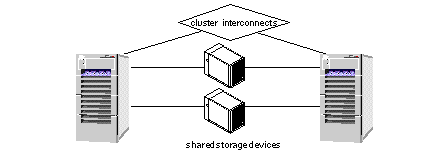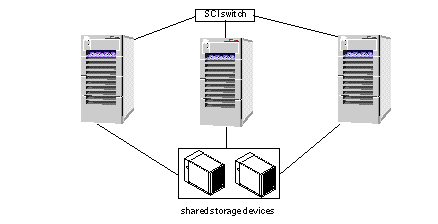High Availability and Parallel Database Configurations
Sun Cluster supports HA data service and parallel database configurations. HA and parallel databases can also be combined within a single cluster, with some restrictions.
Data services in an HA configuration are made highly available by having multiple hosts connected to the same physical disk enclosure. The status of each host is monitored over private interconnects. If one of the hosts fails, another host connected to the same shared storage device can take over the data service work previously done by the failed host. Figure 1-10 shows an example of a highly available data service configuration.
Figure 1-10 Highly Available Data Services Configuration

Oracle Parallel Server (OPS) enables a relational database to be highly available by enabling multiple hosts to access the same data on shared storage devices. Traffic to the shared disk enclosures is controlled by a DLM that prevents two processes from accessing the same data at the same time. High availability is attained by redirecting database access traffic from a failed host to one of the remaining nodes. Figure 1-11 shows an example of a highly available OPS configuration. The private interconnect can be either Scalable Coherent Interface (SCI) or Fast Ethernet.
Figure 1-11 OPS Database Configuration

The Informix-Online XPS parallel database permits parallel access by partitioning the relational database across shared storage devices. Multiple host processes can access the same database simultaneously provided they do not access data stored in the same partition. Access to a particular partition is through a single host, so if that host fails, no access is possible to that partition of data. For this reason, Informix-Online XPS is a parallel database, but cannot be configured to be highly available in a Sun Cluster.
- © 2010, Oracle Corporation and/or its affiliates
